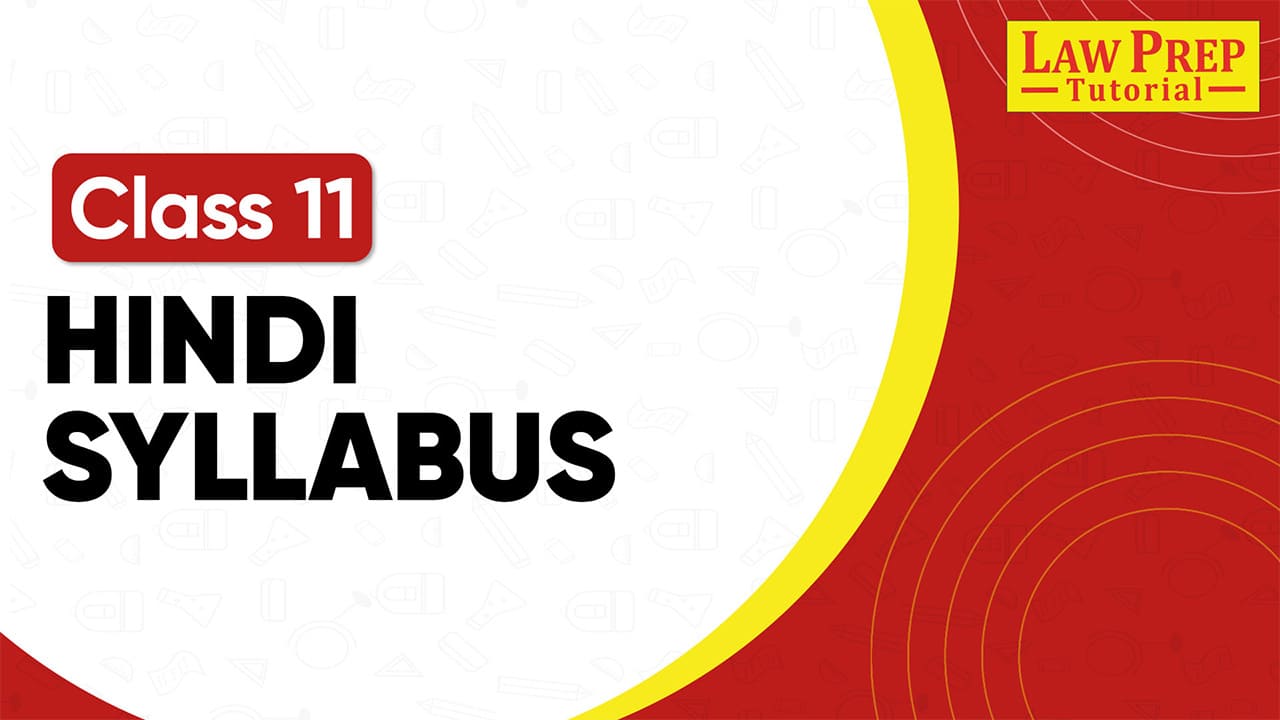The CBSE Class 11th Hindi syllabus plays a crucial role in strengthening students’ command over the Hindi language while enhancing their appreciation for literature and communication skills.
The curriculum introduces learners to a balanced mix of prose, poetry, and supplementary readings from renowned authors and poets.
Along with literature, it focuses on writing skills, grammar, and comprehension to build strong linguistic ability. This Class 11 syllabus for Hindi Core is structured to prepare students not only for academic excellence but also for practical language use in higher studies and professional life.
Class 11th Hindi Syllabus 2025-26 (कक्षा 11 हिंदी पाठ्यक्रम): Overview
Below is the CBSE class 11th Hindi syllabus overview:
| खंड | विवरण | अंक |
| खंड–क (अपठित बोध) | 1. अपठित गद्यांश (लगभग 250 शब्द) पर आधारित प्रश्न 2. अपठित पद्यांश (लगभग 100 शब्द) पर आधारित प्रश्न | 18 |
| खंड–ख (अभिव्यक्ति और माध्यम पाठ्यपुस्तक के आधार पर) | 3. रचनात्मक लेखन (निबंध – लगभग 120 शब्द) 4. औपचारिक पत्र लेखन 5. पाठ संख्या 1, 2, 9, 10, 14, 15, 16 पर आधारित प्रश्न | 22 |
| खंड–ग (आरोह भाग–1 एवं वितान भाग–1 के आधार पर) | 6. पठन काव्यांश पर आधारित बहुविकल्पी प्रश्न 7–8. काव्य खंड पर लघु एवं दीर्घ उत्तरीय प्रश्न 9. पठन गद्यांश पर आधारित बहुविकल्पी प्रश्न 10–11. गद्य खंड पर लघु एवं दीर्घ उत्तरीय प्रश्न 12. वितान के पाठों पर आधारित प्रश्न | 40 |
| आंतरिक मूल्यांकन | श्रवण तथा वाचन – 10 अंक परियोजना कार्य – 10 अंक | 20 |
| कुल अंक | 100 |
Download Class 11 Hindi Syllabus PDF
Download the complete Class 11 Hindi Core Syllabus 2025–26 PDF by CBSE.
CBSE Class 11 Hindi Syllabus: खंड–क (अपठित बोध)
| विषय | विवरण | अंक |
| अपठित गद्यांश | लगभग 250 शब्दों का गद्यांश। इस पर आधारित बोध, चिंतन, विश्लेषण आदि प्रश्न पूछे जाएंगे। प्रश्न प्रकार: बहुविकल्पीय, अति लघु उत्तरीय और लघु उत्तरीय। | 10 |
| अपठित पद्यांश | लगभग 100 शब्दों का पद्यांश। इस पर आधारित सराहना, सौंदर्य, चिंतन, विश्लेषण आदि प्रश्न पूछे जाएंगे। प्रश्न प्रकार: बहुविकल्पीय, अति लघु उत्तरीय और लघु उत्तरीय। | 8 |
| कुल अंक | 18 |
More Important Resources for CBSE Exam:
| Class 11th Hornbill Syllabus | CBSE Class 11th Commerce Subjects |
| CBSE Full Form | All about CBSE Class 11th |
| Class 11th Syllabus | Class 12th Syllabus |
| Class 11th Commerce Books | CBSE Board: All details |
CBSE Class 11 Hindi Syllabus: खंड–ख (अभिव्यक्ति और माध्यम – पाठ्यपुस्तक आधारित)
| विषय | विवरण | अंक |
| रचनात्मक लेखन | दिए गए 3 अप्रत्याशित विषयों में से किसी 1 विषय पर लगभग 120 शब्दों में निबंध लेखन। | 6 |
| औपचारिक पत्र लेखन | औपचारिक पत्र (विकल्प सहित) पर लेखन। | 5 |
| पाठ आधारित प्रश्न | पाठ संख्या 1, 2, 9, 10, 14, 15 एवं 16 पर आधारित प्रश्न। इसमें लघु एवं दीर्घ उत्तरीय प्रश्न शामिल होंगे। | 11 |
| कुल अंक | 22 |
CBSE Class 11 Hindi Syllabus: खंड–ग (आरोह भाग–1 एवं वितान भाग–1 आधारित)
| विषय | विवरण | अंक |
| पठन काव्यांश | पठन काव्यांश पर आधारित 5 बहुविकल्पीय प्रश्न। | 5 |
| काव्य खंड प्रश्न (I) | 3 में से किसी 2 प्रश्नों के उत्तर (लगभग 60 शब्दों में)। | 6 |
| काव्य खंड प्रश्न (II) | 3 में से किसी 2 प्रश्नों के उत्तर (लगभग 40 शब्दों में)। | 4 |
| पठन गद्यांश | पठन गद्यांश पर आधारित 5 बहुविकल्पीय प्रश्न। | 5 |
| गद्य खंड प्रश्न (I) | 3 में से किसी 2 प्रश्नों के उत्तर (लगभग 60 शब्दों में)। | 6 |
| गद्य खंड प्रश्न (II) | 3 में से किसी 2 प्रश्नों के उत्तर (लगभग 40 शब्दों में)। | 4 |
| वितान आधारित प्रश्न | वितान भाग-1 के 3 प्रश्नों में से किसी 2 के उत्तर (लगभग 60 शब्दों में)। | 10 |
| कुल अंक | 40 |
Class 11 Hindi Syllabus: आरोह भाग–1 (Aroh Bhag–1 Chapters)
Below is the list of chapters in class 11th Aroh book:
| खंड | पाठ संख्या | शीर्षक | लेखक / कवि |
| गद्य खंड | 1 | नमक का दरोगा | प्रेमचन्द |
| 2 | मियाँ नसीरुद्दीन | कृष्णा सोबती | |
| 3 | अपू के साथ ढाई साल | सत्यजीत राय | |
| 4 | विदाई–संभाषण | बालमुकुन्द गुप्त | |
| 5 | गिल्लू | शेखर जोशी | |
| 6 | रजनी | मन्नू भंडारी | |
| 7 | जामुन का पेड़ | कुर्रतुलऐन हैदर | |
| 8 | भारत माता | जवाहरलाल नेहरू | |
| काव्य खंड | 1 | हम तो एक एक करि जानां | कबीर |
| 2 | मेरे तो गिरधर गोपाल, दूसरा न कोई | मीराँ | |
| 3 | घर की याद | भवानी प्रसाद मिश्र | |
| 4 | चंपा काले काले अच्छर नहीं चीन्हती | त्रिलोचन | |
| 5 | ग़ज़ल | दुष्यंत कुमार | |
| 6 | (i) हे भूख! मत मचल(ii) हे मेरे जूही के फूल जैसे ईश्वर | अक्कमहादेवी | |
| 7 | सबसे ख़तरनाक | अवतार सिंह पाश | |
| 8 | आओ, मिलकर बचाएँ | निर्मल पुतुल |
Check the latest CBSE Class 11 syllabus for all subjects below:
Class 11 Hindi Syllabus: वितान भाग–1 (Vitan Bhag–1 Chapters)
Below is the list of class 11 Vitan book chapters:
| पाठ संख्या | शीर्षक | लेखक |
| 1 | भारतीय गायिकाओं में बेजोड़: लता मंगेशकर | कुमार गंधर्व |
| 2 | राजस्थान की रजत बूँदें | अनुपम मिश्र |
| 3 | आलों–अँधारि | बेबी हालदार |
| 4 | भारतीय कलाएँ | — |
| 5 | लेखकों के बारे में | — |
कक्षा 11 हिंदी – आरोह से हटाए गए अध्याय (Deleted Chapters)
These are the deleted chapters in class 11 Hindi syllabus for Aroh book:
| खंड | शीर्षक | लेखक / कवि |
| काव्य खंड | संतों देखत जग बौराना (पद 2) | कबीर |
| पग घुंघरू बाँधि मीरा नाची (पद 2) | मीराँ | |
| पथिक (पूरा पाठ) | रामनरेश त्रिपाठी | |
| वे आँखें (पूरा पाठ) | सुमित्रानंदन पंत | |
| गद्य खंड | स्मृति में बारिश (पूरा पाठ) | कृष्णनाथ |
| आत्मा का ताप (पूरा पाठ) | सैयद हैदर रज़ा |
Prescribed Books for CBSE Class 11 Hindi Syllabus
The CBSE Class 11 Hindi Core syllabus is based on NCERT-published textbooks. Students must thoroughly study these books as they cover prose, poetry, supplementary readings, and expression skills.
| क्रम संख्या | पुस्तक का नाम | प्रकाशक |
| 1 | आरोह भाग–1 | एन.सी.ई.आर.टी., नई दिल्ली |
| 2 | वितान भाग–1 | एन.सी.ई.आर.टी., नई दिल्ली |
| 3 | अभिव्यक्ति और माध्यम | एन.सी.ई.आर.टी., नई दिल्ली |
Objectives of CBSE Class 11 Hindi Syllabus
- Language Proficiency: To strengthen students’ ability to read, write, and express effectively in Hindi.
- Comprehension Skills: To develop the ability to understand unseen passages, prose, and poetry with clarity.
- Critical Thinking: To encourage analysis, reflection, and logical interpretation of literary works.
- Creative Expression: To build writing skills through essays, letters, reports, and creative tasks.
- Cultural Awareness: To introduce learners to the richness of Indian culture, traditions, and values through literature.
- Appreciation of Literature: To nurture sensitivity towards poems, stories, and essays by renowned Hindi writers.
- Effective Communication; To improve listening and speaking skills through classroom activities and internal assessment.
- Moral and Social Values: To inspire students by exposing them to literary works that carry ethical and human values.
- Exam Preparedness: To prepare students for structured answers, precise writing, and accurate grammar in board exams.
- Foundation for Higher Studies: To lay a strong base for Class 12 Hindi Core and competitive exam preparation.
Preparation Tips for Class 11 Hindi Core
1. Read Texts Regularly
Go through Aroh and Vitan chapters daily. Focus on summaries, difficult words, and literary devices to build clarity.
2. Practice Unseen Passages
Solve comprehension exercises regularly to improve speed and accuracy in handling unseen passages.
3. Focus on Writing Skills
Write practice essays, letters, and reports. Pay attention to format, grammar, and presentation for scoring high marks.
4. Learn Key Poetic Devices
Note similes, metaphors, and imagery in poetry lessons. This helps in answering appreciation-based questions effectively.
5. Revise Grammar Thoroughly
Strengthen topics like संधि, समास, वाक्य परिवर्तन, and अनुच्छेद लेखन. Grammar ensures easy scoring in exams.
6. Make Short Notes
Prepare crisp notes with important points, author details, and summaries. Revise them before exams for quick recall.
7. Practice Previous Year Papers
Solve sample and past question papers to understand exam pattern, question types, and marking scheme.
8. Prepare for Internal Assessment
Work on listening and speaking skills. Take project work seriously as it adds to your final score.
9. Manage Time Wisely
Divide study hours for prose, poetry, grammar, and writing. Balanced preparation reduces exam stress.
10. Stay Consistent
Regular practice is key. Reading Hindi newspapers and magazines also improves vocabulary and expression.
Read the chapter-wise summaries of Class 11 English here:
FAQs About Class 11 Hindi Core Syllabus
There are three NCERT books – आरोह भाग–1, वितान भाग–1, and अभिव्यक्ति और माध्यम.
The paper carries 80 marks for theory and 20 marks for internal assessment, making a total of 100 marks.
There are 8 prose lessons and 8 poems included in आरोह भाग–1.
वितान भाग–1 has 5 chapters based on prose and cultural themes.
Internal assessment includes listening skills (श्रवण), speaking skills (वाचन), and project work.
Deleted lessons include संतो देखत जग बौराना (कबीर), पग घुंघरू बाँधि मीरा नाची (मीरा), पथिक (रामनरेश त्रिपाठी), वे आँखें (सुमित्रानंदन पंत), स्मृति में बारिश (कृष्णनाथ), and आत्मा का ताप (सैयद हैदर रज़ा).
Essay writing, formal letter writing, notices, reports, and creative composition are part of the exam.
Practice unseen passages regularly from sample papers, focus on speed reading, and improve vocabulary.
Yes, functional grammar and expression skills are part of अभिव्यक्ति और माध्यम.
Yes, NCERT books (Aroh, Vitan, and Abhivyakti aur Madhyam) are sufficient for preparation and board exams.
Revise chapters thoroughly, prepare notes, practice previous year papers, work on grammar and writing skills, and present answers neatly in the exam.
Find detailed questions and answers from all chapters of English Class 11 now:
Explore the updated CBSE Class 12 syllabus for all subjects here:
Discover CLAT exam resources that can help you get started early:
Explore CLAT coaching centers across different cities:

